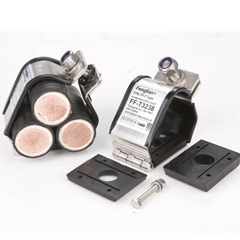|
 |
Cable Cleats are designed to
support and retain your cables within your cable tray system in every
conditions.
More importantly, they prevent the damage in short circuit condition.
Unfortunately, short circuit always happens, and when it do, it's
destructive and dangerous to the cables and cable system.
Cable Cleats are one of the first lines of defense to help
protect the personnel, the cables and the cable system.
How to select the Cable Cleats
1. Know the Cables
Which type of cable is being used, Single or Multi-Conductor?
What is the outer diameter of Cables?
What is the cable arrangement,Flat or Trefoil?
If a ground wire is installed in the cleats, know the outer Diameter of
the ground wire .
2. Know the System
What is the available short circuit current (RMS or IP Peak)?
What type of copper B-line cable tray is installed?
3. Short Circuit Current Test
Short circuit current is an over current resulting from an electrical
fault of negligible impedance between
live conductors or between a live conductor and an earth, having a
difference in potential under normal operating conditions.
RMS current is a calculated value for the initial cycles of the fault.
IP Peak short current is a maximum possible instantaneous value of the
short circuit current.
Electromechanical Force is included forces acting on current carrying
conductors.
Relevant Standard: IEC 61914 |
|
 |
Installation Notes
The cleats should be installed properly to secure the cables.
It is not necessary for every cleat to be attached onto the tray.
Every cleat should be restrained to keep cables bundling.
The bend radius should be 8 to 12 times of the cable diameter.
The cleats should always be installed at the beginning, the middle, the
end of the bend part.
The distance between the cleats on the bend should be no more than 0.3M
from center to center.
Construction Data of the Cable Cleats
Cleat Material
Frame
Closure Hardware
Integral Pad
Tools Required
Mounting Bolt
Performance on the Cable Cleats
Resistance to Electromechanical Force
Lateral Load Test
Axial Load Test
Operating Temperature Range
Resistance to Impact
Needle Flame Test
Resistant to UV light Test |